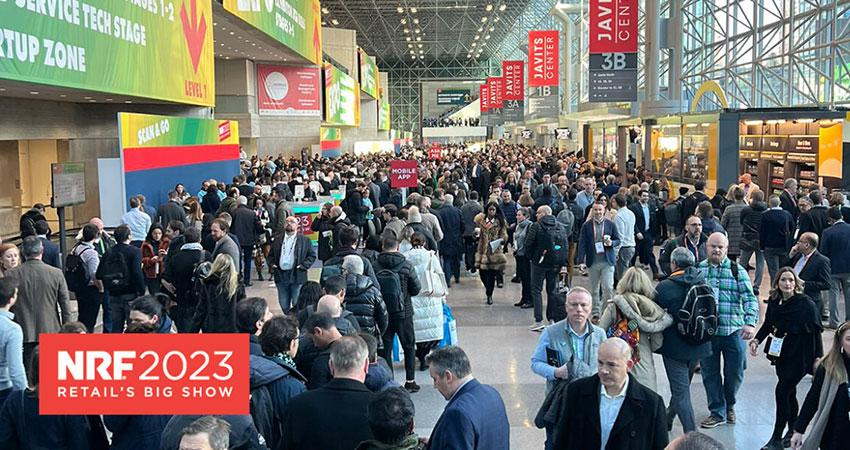Image credit: NRF
The energy level at NRF 2023, aka the Big Show, was palpable, as large crowds swarmed the expo floors and outer halls of the Javits Center in New York, even as holiday numbers from the association itself and the government signaled concerns in the industry and the markets down the street.
In the first year of a fully post-pandemic era (yes I said it), retailers and vendors alike were eager to come out en masse and celebrate physical and digital retail, looking hopefully to the future and offering all manner of data-driven solutions.
Many booth presentations at NRF 2023 had attendees thronged ten deep or more to hear about how a particular technology can help them solve a particular pain point. And exhibitors opened up their wallets to provide some great swag as a lure, including American Express handing out envelopes with $25 gift cards (thanks!) and Shopify with its giveaway kiosks outside the hall (darn!).
Whoever handed out the nice wool scarves at their booth — my wife thanks you!
Virtually all exhibitors I met with at NRF 2023 offered some flavor of machine learning (ML) or artificial intelligence (AI), or both, in their product or platform. Handout slicks and flatscreen demos pointed out how ML and AI drive greater efficiency, more conversions via an irresistible customer promise (a major theme), and a deeper understanding of store traffic, merchandising and buyer behavior.
Data, especially for predictive analytics to help retailers skate to where the puck is going to be, now touches every aspect of retail.
Solving for inventory management was another particularly strong focus area of exhibitors and sessions at NRF 2023, as the industry is now working to get on the other side of extreme glut and carrying costs, and a discount-driven holiday season to lure in shoppers and clear out stocks.
The battle between legacy platforms from major players and headless, API-based microservices architecture from upstart start-ups played out on the expo floor. Refugee developers from the big guns talked about how their better mousetrap provided faster time to value (yet another theme) and greater efficiency and flexibility at a lower TCO.
Speaking of time to value: I heard several times from startup executives some variant on the fact that in 2023, “the CFO is the new CEO.” Many retailers and ecommerce companies, stung by an inflation-fueled pullback, are reducing their capex. A return to profitability is the new prime directive, replacing “keep the customer at any cost.”
The way one explained it to me: “The messaging is now around, (our software) gives you a lot more protection from volatility, as the CFO has an increased focus on risk. We had to adjust our go-to-market. We feel very confident in this approach, based on what we’ve seen in the market.”
Looking at the economics of 2023, Jonathan Silver, founder, president and CEO of payment platform Affinity Solutions, told reporters in a pressroom session that there are hopeful signs in the broader economy and in retail.
“If inflation is ameliorated and wages stay strong, we have a wider runway for a soft landing into 2023,” said Silver, whose company supplies transactional data to investment firms and the U.S. government. And even with consumer confidence challenged, people are still spending, Silver said, as the correlation between the two isn’t as strong as it once was.
“The best way to stimulate the economy is to push money to lower-income households, who push it right back into the economy,” said Mark Matthews, vice president of research for NRF. He noted how retail spending has steadily climbed from 7% growth in the doldrums of 2020 to 14.7% in 2021 and 17% in 2022.
Perhaps so, but that doesn’t happen at a zero cost, with trillions in stimulus spending in two years and the government now bumping up against the debt ceiling.
Matthews also said a six-month look-back shows inflation at a favorable 1.9%, vs. 6.5% from a 12-month comparison as of the end of 2022 from the Department of Labor.
The day after the show closed, NRF reported that holiday spending in November and December grew 5.3% in 2022 to $936.3 billion, excluding automobile, gasoline and restaurants, below its forecast of 6% to 8% growth.
That same day, the U.S. Census Bureau reported that December retail sales, including food but excluding auto and gas, fell 1.1% from November to $677.1 billion, vs. an economist consensus figure of an 0.8% contraction. The previous month it had fallen 1%, adjusted upward from a previous estimate of 0.6%. Year-over-year produced a better picture of 6% growth in December.
In 2023, all eyes are on the back half of the year, as a telling point for the solidity of an economic recovery. We join the industry in looking to the northward markers as hopeful signs.

